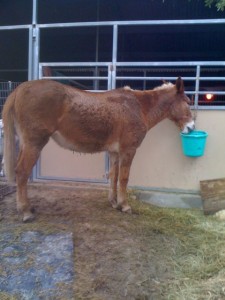I went to one of my client’s recently and she asked me to look at one of her 2 year olds. This filly had a lump on her chest that had been there for over a week. My client had assumed it was from a kick but the lump was hard and not going down. I know this client has a very good horse feeding program in place yet this filly looked thin and rough coated.
With questioning I determined that she had been out with the other 2 year olds in the pasture and she was not at the top of the pecking order. We have had much colder and wetter weather than normal this winter and my client had not adjusted her horse feeding program to fit this filly’s increased nutritional needs.
Normally there was plenty of hay for everyone but with the very cold and wet weather this filly was not getting her share. The pasture horses were not getting any feed supplements either like the horses in the barn. My client felt they did not need anything extra since they were not in training.
The combination of not enough food, adverse weather and no feed supplements left this filly in a weakened state. What she had on her chest was an abscess but because her body was weak she was not able to mount an adequate immune response. Since the filly had been on an excellent feeding program most of her life her body did isolate the infection in a lymph node but then the process stalled for lack of strength to finish the healing process.
The treatment plan was straight forward. We brought the filly to the barn where we knew she would be on the best horse feeding program and would get what she needed. We added in feed supplements of 2 packs of bluegreen algae, probiotics and enzymes a day to give digestive and immune support. We did not start any homeopathy because we knew the filly needed to build up her system before she could react appropriately to a remedy.
Within days the filly gained weight and he coat softened. Then we started the remedy silica 200c once a day for 3 days. By the second day the abscess had enlarged and there was swelling and heat in the area. This told me the filly had to energy to heal. A week later we were able to open the abscess and drain out a large amount of pus. The filly healed quickly and was able to go back to the pasture with her buddies.
A few simple rules would have avoided this problem and these can be easy to forget even on a farm with a great feeding program.
1. Make sure you increase hay for all horses when the weather is extra cold.
2. Make sure all horses are getting their share of the food.
3. Add or increase feed supplements when weather is stressful
4. Monitor the condition of each individual even when your overall horse feeding program seems good.
I know these rules are easy to overlook when it is freezing cold and rainy and you are just trying to get everyone fed and cared for. I have my own horses and have done my fair share of cussing the nasty weather but a few extra moments can save your horse discomfort and possible illness. Madalyn
